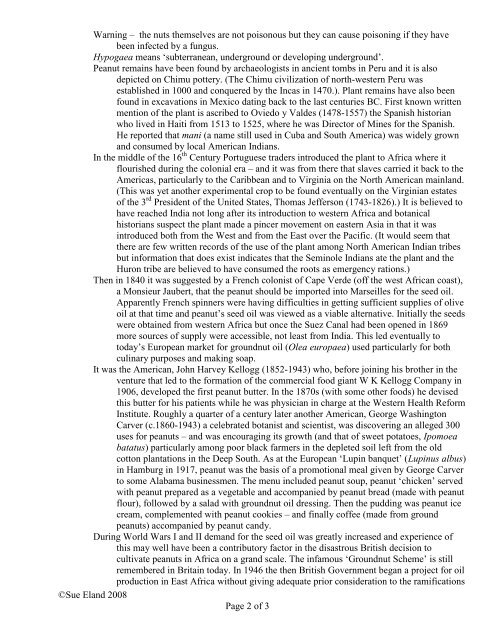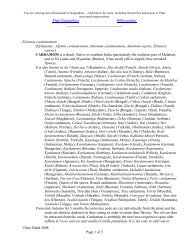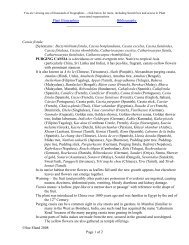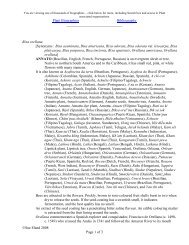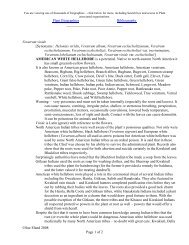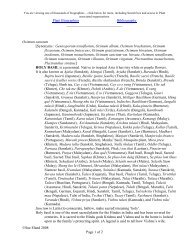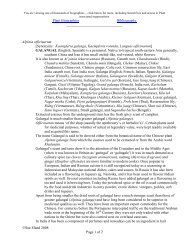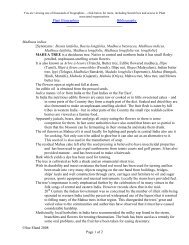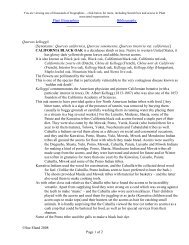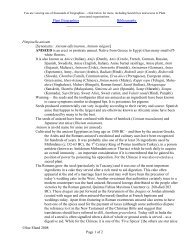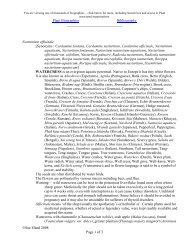You are viewing one of thousands of ... - Plant Biographies
You are viewing one of thousands of ... - Plant Biographies
You are viewing one of thousands of ... - Plant Biographies
Create successful ePaper yourself
Turn your PDF publications into a flip-book with our unique Google optimized e-Paper software.
Warning – the nuts themselves <strong>are</strong> not poisonous but they can cause poisoning if they have<br />
been infected by a fungus.<br />
Hypogaea means ‘subterranean, underground or developing underground’.<br />
Peanut remains have been found by archaeologists in ancient tombs in Peru and it is also<br />
depicted on Chimu pottery. (The Chimu civilization <strong>of</strong> north-western Peru was<br />
established in 1000 and conquered by the Incas in 1470.). <strong>Plant</strong> remains have also been<br />
found in excavations in Mexico dating back to the last centuries BC. First known written<br />
mention <strong>of</strong> the plant is ascribed to Oviedo y Valdes (1478-1557) the Spanish historian<br />
who lived in Haiti from 1513 to 1525, where he was Director <strong>of</strong> Mines for the Spanish.<br />
He reported that mani (a name still used in Cuba and South America) was widely grown<br />
and consumed by local American Indians.<br />
In the middle <strong>of</strong> the 16<br />
©Sue Eland 2008<br />
Page 2 <strong>of</strong> 3<br />
th Century Portuguese traders introduced the plant to Africa where it<br />
flourished during the colonial era – and it was from there that slaves carried it back to the<br />
Americas, particularly to the Caribbean and to Virginia on the North American mainland.<br />
(This was yet another experimental crop to be found eventually on the Virginian estates<br />
<strong>of</strong> the 3 rd President <strong>of</strong> the United States, Thomas Jefferson (1743-1826).) It is believed to<br />
have reached India not long after its introduction to western Africa and botanical<br />
historians suspect the plant made a pincer movement on eastern Asia in that it was<br />
introduced both from the West and from the East over the Pacific. (It would seem that<br />
there <strong>are</strong> few written records <strong>of</strong> the use <strong>of</strong> the plant among North American Indian tribes<br />
but information that does exist indicates that the Seminole Indians ate the plant and the<br />
Huron tribe <strong>are</strong> believed to have consumed the roots as emergency rations.)<br />
Then in 1840 it was suggested by a French colonist <strong>of</strong> Cape Verde (<strong>of</strong>f the west African coast),<br />
a Monsieur Jaubert, that the peanut should be imported into Marseilles for the seed oil.<br />
App<strong>are</strong>ntly French spinners were having difficulties in getting sufficient supplies <strong>of</strong> olive<br />
oil at that time and peanut’s seed oil was viewed as a viable alternative. Initially the seeds<br />
were obtained from western Africa but once the Suez Canal had been opened in 1869<br />
more sources <strong>of</strong> supply were accessible, not least from India. This led eventually to<br />
today’s European market for groundnut oil (Olea europaea) used particularly for both<br />
culinary purposes and making soap.<br />
It was the American, John Harvey Kellogg (1852-1943) who, before joining his brother in the<br />
venture that led to the formation <strong>of</strong> the commercial food giant W K Kellogg Company in<br />
1906, developed the first peanut butter. In the 1870s (with some other foods) he devised<br />
this butter for his patients while he was physician in charge at the Western Health Reform<br />
Institute. Roughly a quarter <strong>of</strong> a century later another American, George Washington<br />
Carver (c.1860-1943) a celebrated botanist and scientist, was discovering an alleged 300<br />
uses for peanuts – and was encouraging its growth (and that <strong>of</strong> sweet potatoes, Ipomoea<br />
batatus) particularly among poor black farmers in the depleted soil left from the old<br />
cotton plantations in the Deep South. As at the European ‘Lupin banquet’ (Lupinus albus)<br />
in Hamburg in 1917, peanut was the basis <strong>of</strong> a promotional meal given by George Carver<br />
to some Alabama businessmen. The menu included peanut soup, peanut ‘chicken’ served<br />
with peanut prep<strong>are</strong>d as a vegetable and accompanied by peanut bread (made with peanut<br />
flour), followed by a salad with groundnut oil dressing. Then the pudding was peanut ice<br />
cream, complemented with peanut cookies – and finally c<strong>of</strong>fee (made from ground<br />
peanuts) accompanied by peanut candy.<br />
During World Wars I and II demand for the seed oil was greatly increased and experience <strong>of</strong><br />
this may well have been a contributory factor in the disastrous British decision to<br />
cultivate peanuts in Africa on a grand scale. The infamous ‘Groundnut Scheme’ is still<br />
remembered in Britain today. In 1946 the then British Government began a project for oil<br />
production in East Africa without giving adequate prior consideration to the ramifications


